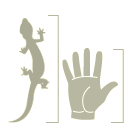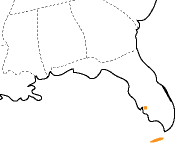Giant Day Gecko
Scientific Name: Phelsuma madagascariensis grandis / Common Names: Giant Day Gecko
|
This brilliant green lizard has daubs and streaks of red to orange "war paint" on the head, neck and body. A few individuals may reach over 11 in. (28 cm) TL, but most adults are 8 - 9 in. (20 - 23 cm) long. Day geckos have expanded toepads, immoveable eyelids, and round pupils. Hatchlings, which are 2.5 in. (6.4 cm) TL, are usually a dull olive color, the bright green and orange of adults only appearing as the lizards grow.
Habitat and Range Established colonies of Giant Day Geckos are known from several of the Florida keys. Specimens have been reported from Broward, Miami-Dade, and Lee Counties as well, but it is not clear that the species is established there. In Hawaii, it has been found in Mänoa Valley, Oahu. The first specimen was collected there in December 1996. Giant Day Geckos have also been found near Pearl Harbor, but it is uncertain whether the species is established there. Even in Madagascar, the Giant Day Gecko is commonly found around buildings and settlements, and in the United States they are most common on buildings and on palms and other nearby trees. Its native range includes northern and northwestern Madagascar. Habits These lizards are agile climbers, seldom seen on the ground. They are diurnal, and are often seen scurrying across walls or tree trunks. At night, they retreat into cracks and crevices on buildings or into the axils of palms and other plants. Besides eating a variety of invertebrates, day geckos lick nectar, pollen and tree sap. In captivity, these geckos have lived for over 20 years. Similar Species This is the only large, bright green lizard with immoveable eyelids known from Florida. The Green Anole (Anolis carolinensis), native to Florida and introduced in Hawaii, and Knight Anole (Anolis equestris), introduced to Florida and Hawaii, are also bright green and have toepads. Green Iguanas (Iguana iguana), found in Florida and Hawaii, and Jackson’s Chameleons (Chamaeleo jacksonii), found in Hawaii, are also green, but lack toepads. All these species have moveable eyelids and lack the bright red or orange markings found on Giant Day Geckos. In Hawaii, the Giant Day Gecko can be distinguished from the Gold Dust and Orange-spotted Day Geckos by its larger size and lack of gold speckling or blue patch on the neck and shoulders. Hatchling day geckos are dull green and lack adult color markings, but at hatching, Giant Day Geckos are 2.5 in. long, a size at which the other species have begun showing some patches of bright green color. Conservation & Other Threats It seems certain that most, if not all, day gecko populations in the United States are the result of deliberate releases by hobbyists or animal importers. It is uncertain whether the Giant Day Gecko will be able to invade Hawaiian forests, but it could be a problem for native invertebrates. This species profile relies heavily on: Bartlett & Bartlett 1999; Henkel & Schmidt 2000; Krysko et al. 2003; Meshaka et al. 2004; http://www.phelsumania.com/public/articles/biogeography_hawaii.html |
Size:
Habitat:
Active During:
Diet:
Color/Pattern:
Location:
|









